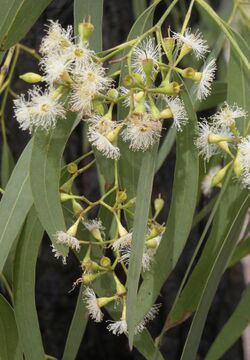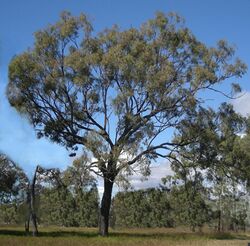Biology:Eucalyptus crebra
| Narrow-leaved ironbark | |
|---|---|

| |
| Scientific classification | |
| Kingdom: | Plantae |
| Clade: | Tracheophytes |
| Clade: | Angiosperms |
| Clade: | Eudicots |
| Clade: | Rosids |
| Order: | Myrtales |
| Family: | Myrtaceae |
| Genus: | Eucalyptus |
| Species: | E. crebra
|
| Binomial name | |
| Eucalyptus crebra | |
| Synonyms[2] | |
|
Synonyms
| |
Eucalyptus crebra, commonly known as the narrow-leaved ironbark, narrow-leaved red ironbark or simply ironbark,[3] and as muggago in the indigenous Dharawal language,[4] is a species of small to medium-sized tree endemic to eastern Australia . It has hard, rough "ironbark" from its trunk to small branches, linear to lance-shaped adult leaves, flower buds in groups of seven, nine or eleven, white flowers and cup-shaped, barrel-shaped or hemispherical fruit. A variable species, it grows in woodland and forest from the Cape York Peninsula to near Sydney. It is an important source of nectar in the honey industry and its hard, strong timber is used in construction.
thumb|fruit
Description
Eucalyptus crebra is a tree that typically grows to a height of 35 m (115 ft) and forms a lignotuber. It has persistent thick, rough, deeply furrowed, greyish black "ironbark" from the base of its trunk to the small branches. Young plants and coppice regrowth have linear to lance-shaped or curved leaves 50–120 mm (2.0–4.7 in) long and 6–17 mm (0.24–0.67 in) wide. Adult leaves are linear to lance-shaped, the same dull green to greyish colour on both sides, 55–180 mm (2.2–7.1 in) long and 7–27 mm (0.28–1.06 in) wide on a petiole 7–20 mm (0.28–0.79 in) long. The flower buds are arranged in groups of seven, nine or eleven, usually on a branching inflorescence on the ends of branchlets. Each group is carried on a peduncle 2–13 mm (0.079–0.512 in) long, the individual buds on a pedicel 2–7 mm (0.079–0.276 in) long. Mature buds are club-shaped, spindle-shaped, or diamond-shaped to oval, 3–7 mm (0.12–0.28 in) long and 2–4 mm (0.079–0.157 in) wide and green to yellow with a conical to rounded operculum. Flowering has been recorded in most months and the flowers are white. The fruit is a woody cup-shaped, barrel-shaped or hemispherical capsule 2–7 mm (0.079–0.276 in) long and 2.5–6 mm (0.098–0.236 in) wide on a pedicel 1–6 mm (0.039–0.236 in) long.[3][4][5]
Taxonomy and naming
Eucalyptus crebra was first formally described in Journal and Proceedings of the Linnean Society, Botany by Victorian state botanist Ferdinand von Mueller in 1859.[6][7] The specific epithet is the Latin adjective crebra meaning "thick", "close" or "numerous",[8][9] referring to the species' abundance.[3]
Narrow-leaved ironbark has included several species, including E. drepanophylla and E. xanthoclada but these are regarded as synonyms by the Australian Plant Census. Eucalyptus repanophylla is accepted as a separate species by the Queensland Government.[2][10] Other similar species include E. exilipes, E. granitica, E. staigeriana, E. quadricostata and E. whitei.[3]
Distribution and habitat
The narrow-leaved ironbark grows in sandy soils in woodland and forest from Picton, southwest of Sydney, north through New South Wales and Queensland to the vicinity of Cairns.[3][4][9]
Uses
The tree has a hard, strong, and dark red timber, which has been used for sleepers and construction.[9] A plank has been recorded as being used for Elizabeth Farm, Australia's oldest surviving European dwelling.[11] It is used as a shade tree or to line roadways, and is also available as a cultivar. It is useful in honey production as the flowers are heavy in nectar and pollen;[9] the resulting honey produced by bees is light-coloured and delicately flavoured.[12]
Gallery
References
- ↑ Fensham, R.; Collingwood, T.; Laffineur, B. (2019). "Eucalyptus crebra". IUCN Red List of Threatened Species 2019: e.T133375138A133375140. doi:10.2305/IUCN.UK.2019-3.RLTS.T133375138A133375140.en. https://www.iucnredlist.org/species/133375138/133375140. Retrieved 18 November 2021.
- ↑ 2.0 2.1 2.2 "Eucalyptus crebra". Australian Plant Census. https://biodiversity.org.au/nsl/services/apc-format/display/114499.
- ↑ 3.0 3.1 3.2 3.3 3.4 "Eucalyptus crebra". Euclid: Centre for Australian National Biodiversity Research. https://apps.lucidcentral.org/euclid/text/entities/eucalyptus_crebra.htm.
- ↑ 4.0 4.1 4.2 Hill, Ken (1999). "Eucalyptus crebra F.Muell.". PlantNet - New South Wales Flora Online. Royal Botanic Gardens & Domain Trust, Sydney Australia. http://plantnet.rbgsyd.nsw.gov.au/cgi-bin/NSWfl.pl?page=nswfl&lvl=sp&name=Eucalyptus~crebra.
- ↑ Chippendale, George M.. "Eucalyptus crebra". Australian Biological Resources Study, Department of the Environment and Energy, Canberra. https://profiles.ala.org.au/opus/foa/profile/Eucalyptus%20crebra.
- ↑ "Eucalyptus crebra". APNI. https://id.biodiversity.org.au/instance/apni/456095.
- ↑ von Mueller, Ferdinand (1859). "Monograph of the Eucalypti of tropical Australia". Journal of the Proceedings of the Linnean Society, Botany 3: 87. https://www.biodiversitylibrary.org/item/8353#page/91/mode/1up. Retrieved 17 May 2019.
- ↑ Brown, Roland Wilbur (1956). The Composition of Scientific Words. Washington, D.C.: Smithsonian Institution Press. p. 790.
- ↑ 9.0 9.1 9.2 9.3 Elliot, Rodger W.; Jones, David L. (1986). "Eu-Go". in Elliot, Rodger W.. Encyclopaedia of Australian Plants suitable for cultivation. 4. Lothian Publishing. pp. 66–67. ISBN 0-85091-213-X.
- ↑ "Eucalyptus drepanophylla". Queensland Government department of Environment and Science. https://wetlandinfo.des.qld.gov.au/wetlands/ecology/components/species/?eucalyptus-drepanophylla.
- ↑ D'Hub (Design Hub). "D6911 Timber specimen (plank), Ironbark (Eucalyptus crebra), used in the building of stables at Elizabeth Farm, Rose Hill, New South Wales, Australia, 1793". D'hub - Your online design resource. Powerhouse Museum, Sydney. http://www.dhub.org/object/224294,swann.[yes|permanent dead link|dead link}}]
- ↑ Capilano Honey (2006). "Floral Varieties". Capilano Honey. Capilano Honey. http://www.capilano.com.au/education/floral-varieties.aspx.
External links
Wikidata ☰ Q3059456 entry
 |







